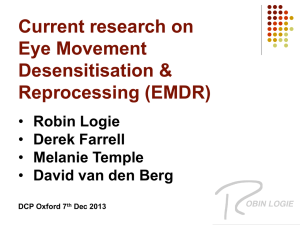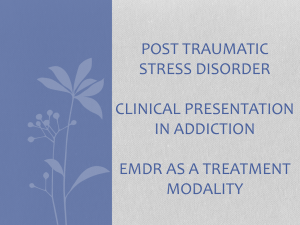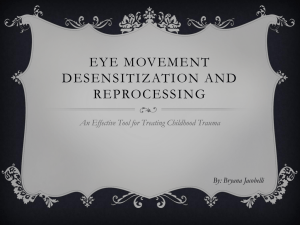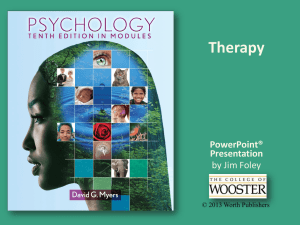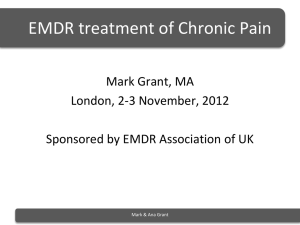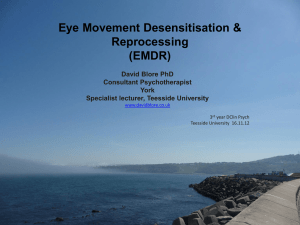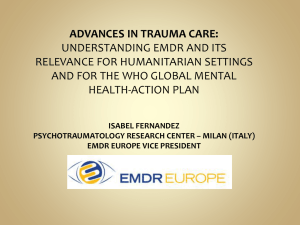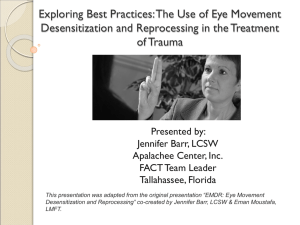International Treatment Guidelines
advertisement
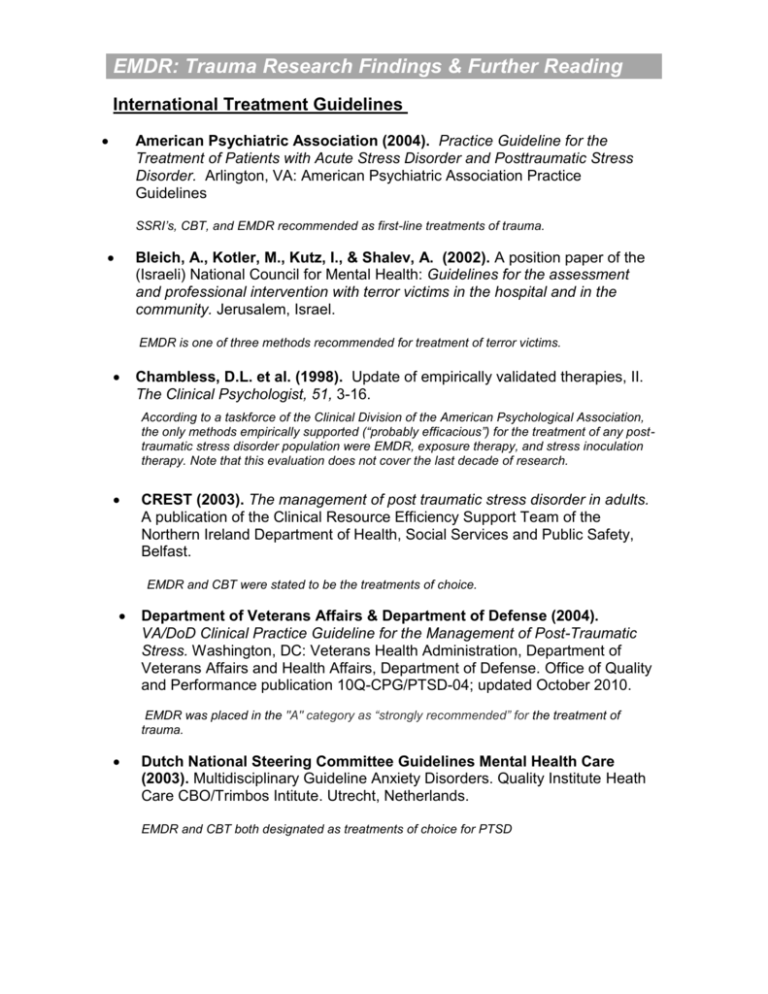
EMDR: Trauma Research Findings & Further Reading International Treatment Guidelines American Psychiatric Association (2004). Practice Guideline for the Treatment of Patients with Acute Stress Disorder and Posttraumatic Stress Disorder. Arlington, VA: American Psychiatric Association Practice Guidelines SSRI’s, CBT, and EMDR recommended as first-line treatments of trauma. Bleich, A., Kotler, M., Kutz, I., & Shalev, A. (2002). A position paper of the (Israeli) National Council for Mental Health: Guidelines for the assessment and professional intervention with terror victims in the hospital and in the community. Jerusalem, Israel. EMDR is one of three methods recommended for treatment of terror victims. Chambless, D.L. et al. (1998). Update of empirically validated therapies, II. The Clinical Psychologist, 51, 3-16. According to a taskforce of the Clinical Division of the American Psychological Association, the only methods empirically supported (“probably efficacious”) for the treatment of any posttraumatic stress disorder population were EMDR, exposure therapy, and stress inoculation therapy. Note that this evaluation does not cover the last decade of research. CREST (2003). The management of post traumatic stress disorder in adults. A publication of the Clinical Resource Efficiency Support Team of the Northern Ireland Department of Health, Social Services and Public Safety, Belfast. EMDR and CBT were stated to be the treatments of choice. Department of Veterans Affairs & Department of Defense (2004). VA/DoD Clinical Practice Guideline for the Management of Post-Traumatic Stress. Washington, DC: Veterans Health Administration, Department of Veterans Affairs and Health Affairs, Department of Defense. Office of Quality and Performance publication 10Q-CPG/PTSD-04; updated October 2010. EMDR was placed in the "A" category as “strongly recommended” for the treatment of trauma. Dutch National Steering Committee Guidelines Mental Health Care (2003). Multidisciplinary Guideline Anxiety Disorders. Quality Institute Heath Care CBO/Trimbos Intitute. Utrecht, Netherlands. EMDR and CBT both designated as treatments of choice for PTSD EMDR Research & Reading Page 2 of 17 Foa, E.B., Keane, T.M., Friedman, M.J. & Cohen, J.A. (2009). Effective treatments for PTSD: Practice Guidelines of the International Society for Traumatic Stress Studies New York: Guilford Press. EMDR was ranked as an evidence-based, Level A treatment for PTSD in adults. INSERM (2004). Psychotherapy: An evaluation of three approaches. French National Institute of Health and Medical Research, Paris, France. EMDR and CBT were stated to be the treatments of choice for trauma victims. National Institute for Clinical Excellence (2005). Post traumatic stress disorder (PTSD): The management of adults and children in primary and secondary care. London: NICE Guidelines. Trauma-focused CBT and EMDR were stated to be empirically supported treatments for choice for adult PTSD. SAMHSA¹s National Registry of Evidence-based Programs and Practices (2011). The Substance Abuse and Mental Health Services Administration (SAMHSA) is an agency of the U.S. Department of Health and Human Services (HHS). This national registry (NREPP) cites EMDR as evidence based practice for treatment of PTSD, anxiety, and depression symptoms. Their review of the evidence also indicated that EMDR leads to an improvement in mental health functioning. http://nrepp.samhsa.gov/ViewIntervention.aspx?id=199 Therapy Advisor (2004-7): http://www.therapyadvisor.com An NIMH sponsored website listing empirically supported methods for a variety of disorders. EMDR is one of three treatments listed for PTSD. United Kingdom Department of Health (2001). Treatment choice in psychological therapies and counseling evidence based clinical practice guideline. London, England. Best evidence of efficacy was reported for EMDR, exposure, and stress inoculation Meta-analyses EMDR has been compared to numerous exposure therapy protocols, with and without CT techniques. It should be noted that exposure therapy uses one to two hours of daily homework and EMDR uses none. The most recent meta-analyses are listed here. Bisson, J., & Andrew, M. (2007). Psychological treatment of post-traumatic stress disorder (PTSD). Cochrane Database of Systematic Reviews 2007, Issue 3. Art. No.: CD003388. DOI: 10.1002/14651858.CD003388.pub3. EMDR Research & Reading Page 3 of 17 “Trauma focused cognitive behavioural therapy and eye movement desensitisation and reprocessing have the best evidence for efficacy at present and should be made available to PTSD sufferers.” Bradley, R., Greene, J., Russ, E., Dutra, L., & Westen, D. (2005). A multidimensional meta-analysis of psychotherapy for PTSD. American Journal of Psychiatry, 162, 214-227. EMDR is equivalent to exposure and other cognitive behavioral treatments and all “are highly efficacious in reducing PTSD symptoms.” Davidson, P.R., & Parker, K.C.H. (2001). Eye movement desensitization and reprocessing (EMDR): A meta-analysis. Journal of Consulting and Clinical Psychology, 69, 305-316. EMDR is equivalent to exposure and other cognitive behavioral treatments. Maxfield, L., & Hyer, L.A. (2002). The relationship between efficacy and methodology in studies investigating EMDR treatment of PTSD. Journal of Clinical Psychology, 58, 23-41. A comprehensive meta-analysis reported the more rigorous the study, the larger the effect. Seidler, G.H., & Wagner, F.E. (2006). Comparing the efficacy of EMDR and trauma-focused cognitive-behavioral therapy in the treatment of PTSD: a meta-analytic study. Psychological Medicine, 36, 1515-1522. “Results suggest that in the treatment of PTSD, both therapy methods tend to be equally efficacious.” Randomized Clinical Trials Abbasnejad, M., Mahani, K. N., & Zamyad, A. (2007). Efficacy of "eye movement desensitization and reprocessing" in reducing anxiety and unpleasant feelings due to earthquake experience. Psychological Research, 9 (3-4), 104-117. “EMDR is effective in reducing earthquake anxiety and negative emotions (e.g. PTSD, grief, fear, intrusive thoughts, depression, etc) resulting from earthquake experience. Furthermore, results show that, improvement due to EMDR was maintained at a one month follow up.” Ahmad A, Larsson B, Sundelin-Wahlsten V. (2007). EMDR treatment for children with PTSD: Results of a randomized controlled trial. Nord J Psychiatry, 61, 349-54. EMDR was found to be an effective treatment in children with PTSD from various sources and who were suffering from a variety of co-morbid conditions. EMDR Research & Reading Page 4 of 17 Carlson, J., Chemtob, C.M., Rusnak, K., Hedlund, N.L, & Muraoka, M.Y. (1998). Eye movement desensitization and reprocessing (EMDR): Treatment for combat-related post-traumatic stress disorder. Journal of Traumatic Stress, 11, 3-24. Twelve sessions of EMDR eliminated post-traumatic stress disorder in 77.7% of the multiply traumatized combat veterans studied. There was 100% retention in the EMDR condition. Effects were maintained at follow-up. This is the only randomized study to provide a full course of treatment with combat veterans. Other studies (e.g., Boudewyns/Devilly/Jensen/Pitman et al./Macklin et al.) evaluated treatment of only one or two memories, which, according to the International Society for Traumatic Stress Studies Practice Guidelines (2000), is inappropriate for multiple-trauma survivors. The VA/DoD Practice Guideline (2004) also indicates these studies (often with only two sessions) offered insufficient treatment doses for veterans. Chemtob, C.M., Nakashima, J., & Carlson, J.G. (2002). Brief-treatment for elementary school children with disaster-related PTSD: A field study. Journal of Clinical Psychology, 58, 99-112. EMDR was found to be an effective treatment for children with disaster-related PTSD who had not responded to another intervention. Edmond, T., Rubin, A., & Wambach, K. (1999). The effectiveness of EMDR with adult female survivors of childhood sexual abuse. Social Work Research, 23, 103-116. EMDR treatment resulted in lower scores (fewer clinical symptoms) on all four of the outcome measures at the three-month follow-up, compared to those in the routine treatment condition. The EMDR group also improved on all standardized measures at 18 months follow up (Edmond & Rubin, 2004, Journal of Child Sexual Abuse). Edmond, T., Sloan, L., & McCarty, D. (2004). Sexual abuse survivors’ perceptions of the effectiveness of EMDR and eclectic therapy: A mixedmethods study. Research on Social Work Practice, 14, 259-272. Combination of qualitative and quantitative analyses of treatment outcomes with important implications for future rigorous research. Survivors’ narratives indicate that EMDR produces greater trauma resolution, while within eclectic therapy, survivors more highly value their relationship with their therapist, through whom they learn effective coping strategies. Hogberg, G. et al., (2007). On treatment with eye movement desensitization and reprocessing of chronic post-traumatic stress disorder in public transportation workers: A randomized controlled study. Nordic Journal of Psychiatry, 61, 54-61. Employees who had experienced “person-under-train accident or had been assaulted at work were recruited.” Six sessions of EMDR resulted in remission of PTSD in 67% compared to 11% in the wait list control. Significant effects were documented in Global Assessment of Function (GAF) and Hamilton Depression (HAM-D) score. Ironson, G.I., Freund, B., Strauss, J.L., & Williams, J. (2002). Comparison of two treatments for traumatic stress: A community-based EMDR Research & Reading Page 5 of 17 study of EMDR and prolonged exposure. Journal of Clinical Psychology, 58, 113-128. Both EMDR and prolonged exposure produced a significant reduction in PTSD and depression symptoms. This is the only research comparing EMDR and exposure therapy that equalized homework. The study found that 70% of EMDR participants achieved a good outcome in three active treatment sessions, compared to 29% of persons in the prolonged exposure condition. EMDR also had fewer dropouts. Jaberghaderi, N., Greenwald, R., Rubin, A., Dolatabadim S., & Zand, S.O. (2004). A comparison of CBT and EMDR for sexually abused Iranian girls. Clinical Psychology and Psychotherapy, 11, 358-368. Both EMDR and CBT produced significant reduction in PTSD and behavior problems. EMDR was significantly more efficient, using approximately half the number of sessions to achieve results. Lee, C., Gavriel, H., Drummond, P., Richards, J. & Greenwald, R. (2002). Treatment of post-traumatic stress disorder: A comparison of stress inoculation training with prolonged exposure and eye movement desensitization and reprocessing. Journal of Clinical Psychology, 58, 10711089. Both EMDR and stress inoculation therapy plus prolonged exposure (SITPE) produced significant improvement, with EMDR achieving greater improvement on PTSD intrusive symptoms. Participants in the EMDR condition showed greater gains at three-month followup. EMDR required three hours of homework compared to 28 hours for SITPE. Marcus, S., Marquis, P. & Sakai, C. (1997). Controlled study of treatment of PTSD using EMDR in an HMO setting. Psychotherapy, 34, 307-315 Funded by Kaiser Permanente. Results show that 100% of single-trauma and 77% of multipletrauma survivors were no longer diagnosed with post-traumatic stress disorder after six 50minute sessions. Marcus, S., Marquis, P. & Sakai, C. (2004). Three- and 6-month follow-up of EMDR treatment of PTSD in an HMO setting. International Journal of Stress Management, 11, 195-208. Funded by Kaiser Permanente, follow-up evaluation indicates that a relatively small number of EMDR sessions result in substantial benefits that are maintained over time. Power, K.G., McGoldrick, T., Brown, K., et al. (2002). A controlled comparison of eye movement desensitization and reprocessing versus exposure plus cognitive restructuring, versus waiting list in the treatment of post-traumatic stress disorder. Journal of Clinical Psychology and Psychotherapy, 9, 299-318. Both EMDR and exposure therapy plus cognitive restructuring (with daily homework) produced significant improvement. EMDR was more beneficial for depression, and social functioning, and required fewer treatment sessions. Subsequent reevaluation of the data indicated that “For pre- to post-treatment IES mean change score, EMDR patients also EMDR Research & Reading Page 6 of 17 appeared to have had better treatment outcome than E+CR patients” and EMDR therapy was a predictor of positive outcome: Karatzias, A., Power, K. McGoldrick, T., Brown, K., Buchanan, R., Sharp, D. & Swanson, V. (2006). Predicting treatment outcome on three measures for post-traumatic stress disorder. Eur Arch Psychiatry Clin Neuroscience, 20, 1-7. Rothbaum, B. (1997). A controlled study of eye movement desensitization and reprocessing in the treatment of post-traumatic stress disordered sexual assault victims. Bulletin of the Menninger Clinic, 61, 317-334. Three 90-minute sessions of EMDR eliminated post-traumatic stress disorder in 90% of rape victims. Rothbaum, B.O., Astin, M.C., & Marsteller, F. (2005). Prolonged exposure versus eye movement desensitization (EMDR) for PTSD rape victims. Journal of Traumatic Stress, 18, 607-616. In this NIMH funded study both treatments were effective: “An interesting potential clinical implication is that EMDR seemed to do equally well in the main despite less exposure and no homework. It will be important for future research to explore these issues.” Scheck, M., Schaeffer, J.A., & Gillette, C. (1998). Brief psychological intervention with traumatized young women: The efficacy of eye movement desensitization and reprocessing. Journal of Traumatic Stress, 11, 25-44. Two sessions of EMDR reduced psychological distress in traumatized young women and brought scores within one standard deviation of the norm. Shapiro, F. (1989). Efficacy of the eye movement desensitization procedure in the treatment of traumatic memories. Journal of Traumatic Stress Studies, 2, 199–223. Seminal study appeared the same year as first controlled studies of CBT treatments. Three-month follow-up indicated substantial effects on distress and behavioral reports. Marred by lack of standardized measures and the originator serving as sole therapist. Soberman, G. B., Greenwald, R., & Rule, D. L. (2002). A controlled study of eye movement desensitization and reprocessing (EMDR) for boys with conduct problems. Journal of Aggression, Maltreatment, and Trauma, 6, 217236. The addition of three sessions of EMDR resulted in large and significant reductions of memory-related distress, and problem behaviors by 2-month follow-up. Taylor, S. et al. (2003). Comparative efficacy, speed, and adverse effects of three PTSD treatments: Exposure therapy, EMDR, and relaxation training. Journal of Consulting and Clinical Psychology, 71, 330-338. The only randomized study to show exposure statistically superior to EMDR on two subscales (out of 10). This study used therapist assisted “in vivo” exposure, where the therapist takes the person to previously avoided areas, in addition to imaginal exposure and one hour of daily homework (@ 50 hours). The EMDR group used only standard sessions and no homework. EMDR Research & Reading Page 7 of 17 Vaughan, K., Armstrong, M.F., Gold, R., O'Connor, N., Jenneke, W., & Tarrier, N. (1994). A trial of eye movement desensitization compared to image habituation training and applied muscle relaxation in post-traumatic stress disorder. Journal of Behavior Therapy & Experimental Psychiatry, 25, 283-291. All treatments led to significant decreases in PTSD symptoms for subjects in the treatment groups as compared to those on a waiting list, with a greater reduction in the EMDR group, particularly with respect to intrusive symptoms. In the 2-3 weeks of the study, 40-60 additional minutes of daily homework were part of the treatment in the other two conditions. Van der Kolk, B., Spinazzola, J. Blaustein, M., Hopper, J. Hopper, E., Korn, D., & Simpson, W. (2007). A randomized clinical trial of EMDR, fluoxetine and pill placebo in the treatment of PTSD: Treatment effects and long-term maintenance. Journal of Clinical Psychiatry, 68, 37-46. EMDR was superior to both control conditions in the amelioration of both PTSD symptoms and depression. Upon termination of therapy, the EMDR group continued to improve while the Fluoxetine participants again became symptomatic. Wilson, S., Becker, L.A., & Tinker, R.H. (1995). Eye movement desensitization and reprocessing (EMDR): Treatment for psychologically traumatized individuals. Journal of Consulting and Clinical Psychology, 63, 928-937. Three sessions of EMDR produced clinically significant change in traumatized civilians on multiple measures. Wilson, S., Becker, L.A., & Tinker, R.H. (1997). Fifteen-month follow-up of eye movement desensitization and reprocessing (EMDR) treatment of posttraumatic stress disorder and psychological trauma. Journal of Consulting and Clinical Psychology, 65, 1047-1056. Follow-up at 15 months showed maintenance of positive treatment effects with 84% remission of PTSD diagnosis. Non Randomized Studies Devilly, G.J., & Spence, S.H. (1999). The relative efficacy and treatment distress of EMDR and a cognitive behavioral trauma treatment protocol in the amelioration of post-traumatic stress disorder. Journal of Anxiety Disorders, 13, 131-157. This study found CBT superior to EMDR. The research is marred by higher expectations in the CBT condition: Treatment was delivered in both conditions by the developer of the CBT protocol. EMDR Research & Reading Page 8 of 17 Fernandez, I., Gallinari, E., & Lorenzetti, A. (2004). A school- based EMDR intervention for children who witnessed the Pirelli building airplane crash in Milan, Italy. Journal of Brief Therapy, 2, 129-136. A group intervention of EMDR was provided to 236 schoolchildren exhibiting PTSD symptoms 30 days post-incident. At four-month follow up, teachers reported that all but two children evinced a return to normal functioning after treatment. Grainger, R.D., Levin, C., Allen-Byrd, L., Doctor, R.M. & Lee, H. (1997). An empirical evaluation of eye movement desensitization and reprocessing (EMDR) with survivors of a natural catastrophe. Journal of Traumatic Stress, 10, 665-671. A study of Hurricane Andrew survivors found significant differences on the Impact of Event Scale and subjective distress in a comparison of EMDR and non-treatment condition. Jarero, I., Artigas, L., & Hartung, J. (2006). EMDR integrative group treatment protocol: A post-disaster trauma intervention for children and adults. Traumatology, 12, 121-129. A study of 200 children treated with a group protocol after a flood in Mexico indicates that one session of treatment reduced trauma symptoms from the severe range to low (subclinical) levels of distress. Data from successful treatment at other disaster sites are also reported. Konuk, E., Knipe, J., Eke, I., Yuksek, H., Yurtsever, A., & Ostep, S. (2006). The effects of EMDR therapy on post-traumatic stress disorder in survivors of the 1999 Marmara, Turkey, earthquake. International Journal of Stress Management, 13, 291-308. Data reported on a representative sample of 1500 earthquake victims indicated that five sessions of EMDR successfully eliminated PTSD in 92.7% of those treated, with a reduction of symptoms in the remaining participants. Puffer, M.; Greenwald, R. & Elrod, D. (1997). A single session EMDR study with twenty traumatized children and adolescents. Traumatology-e, 3(2), Article 6. In this delayed treatment comparison, over half of the participants moved from clinical to normal levels on the Impact of Events Scale, and all but 3 showed at least partial symptom relief on several measures at 1-3 m following a single EMDR session. Silver, S.M., Brooks, A., & Obenchain, J. (1995). Eye movement desensitization and reprocessing treatment of Vietnam war veterans with PTSD: Comparative effects with biofeedback and relaxation training. Journal of Traumatic Stress, 8, 337-342. One of only two EMDR research studies that evaluated a clinically relevant course of EMDR treatment with combat veterans (e.g., more than one or two memories; see Carlson et al., EMDR Research & Reading Page 9 of 17 above). The analysis of an inpatient veterans’ PTSD program (n=100) found EMDR to be superior to biofeedback and relaxation training on seven of eight measures. Silver, S.M., Rogers, S., Knipe, J., & Colelli, G. (2005). EMDR therapy following the 9/11 terrorist attacks: A community-based intervention project in New York City. International Journal of Stress Management, 12, 29-42. Clients made highly significant positive gains on a range of outcome variables, including validated psychometrics and self-report scales. Analyses of the data indicate that EMDR is a useful treatment intervention both in the immediate aftermath of disaster as well as later. Solomon, R.M. & Kaufman, T.E. (2002). A peer support workshop for the treatment of traumatic stress of railroad personnel: Contributions of eye movement desensitization and reprocessing (EMDR). Journal of Brief Therapy, 2, 27-33, 60 railroad employees who had experienced fatal grade crossing accidents were evaluated for workshop outcomes, and for the additive effects of EMDR treatment. Although the workshop was successful, in this setting, the addition of a short session of EMDR (5-40 minutes) led to significantly lower, sub clinical, scores which further decreased at follow up. Sprang, G. (2001). The use of eye movement desensitization and reprocessing (EMDR) in the treatment of traumatic stress and complicated mourning: Psychological and behavioral outcomes. Research on Social Work Practice, 11, 300-320. In a multi-site study, EMDR significantly reduced symptoms more often than the CBT treatment on behavioral measures, and on four of five psychosocial measures. EMDR was more efficient, inducing change at an earlier stage and requiring fewer sessions. Adaptive Information Processing, and EMDR Procedures, The Adaptive Information Processing model (Shapiro, 2001, 2002, 2007) is used to explain EMDR's clinical effects and guide clinical practice. This model is not linked to any specific neurobiological mechanism since the field of neurobiology is as yet unable to determine this in any form of psychotherapy (nor of most medications). This section includes literature to provide an overview of the model and procedures, as well as selected research and case reports that demonstrate the predictive value of the model in the treatment of life experiences that appear to underlie a variety of clinical complaints. Brown, K. W., McGoldrick, T., & Buchanan, R. (1997). Body dysmorphic disorder: Seven cases treated with eye movement desensitization and reprocessing. Behavioural and Cognitive Psychotherapy, 25, 203–207. Seven consecutive cases were treated with up to three sessions of EMDR. Complete remission of BDD symptoms were reported in five cases with effects maintained at oneyear follow-up. EMDR Research & Reading Page 10 of 17 Mol, S. S. L., Arntz, A., Metsemakers, J. F. M., Dinant, G., Vilters-Van Montfort, P. A. P., & Knottnerus, A. (2005). Symptoms of post-traumatic stress disorder after non-traumatic events: Evidence from an open population study. British Journal of Psychiatry, 186, 494–499. Supports a basic tenet of the Adaptive Information Processing model that “Life events can generate at least as many PTSD symptoms as traumatic events.” In a survey of 832 people, “For events from the past 30 years the PTSD scores were higher after life events than after traumatic event.” Perkins, B.R. & Rouanzoin, C.C. (2002). A critical evaluation of current views regarding eye movement desensitization and reprocessing (EMDR): Clarifying points of confusion. Journal of Clinical Psychology, 58, 77-97. Reviews common errors and misperceptions of the procedures, research, and theory. Raboni, M.R., Tufik, S., and Suchecki, D. (2006). Treatment of PTSD by eye movement desensitization and reprocessing improves sleep quality, quality of life and perception of stress. Annals of the New York Academy of Science, 1071, 508-513. Specifically citing the hypothesis that EMDR induces processing effects similar to REM sleep (see also Stickgold, 2002), polysomnograms indicated a change in sleep patterns post treatment, and improvement on all measures including anxiety, depression, and quality of life after a mean of five sessions. Ray, A. L. & Zbik, A. (2001). Cognitive behavioral therapies and beyond. In C. D. Tollison, J. R. Satterhwaite, & J. W. Tollison (Eds.) Practical Pain Management (3rd ed.; pp. 189-208). Philadelphia: Lippincott. The authors note that the application of EMDR guided by the Adaptive Information Processing model appears to afford benefits to chronic pain patients not found in other treatments. Ricci, R. J., Clayton, C. A., & Shapiro, F. (2006). Some effects of EMDR treatment with previously abused child molesters: Theoretical reviews and preliminary findings. Journal of Forensic Psychiatry and Psychology, 17, 538-562. As predicted by the Adaptive Information Processing model the EMDR treatment of the molesters’ own childhood victimization resulted in a decrease in deviant arousal as measured by the plethysmograph, a decrease in sexual thoughts, and increased victim empathy. Effects maintained at one year follow up. Russell, M. (2008). Treating traumatic amputation-related phantom limb pain: a case study utilizing eye movement desensitization and reprocessing (EMDR) within the armed services. Clinical Case Studies, 7: 136-153. “Since September 2006, over 725 service-members from the global war on terrorism have survived combat-related traumatic amputations that often result in phantom limb pain (PLP) EMDR Research & Reading Page 11 of 17 syndrome. . . . Four sessions of Eye Movement Desensitization and Reprocessing (EMDR) led to elimination of PLP, and a significant reduction in PTSD, depression, and phantom limb tingling sensations.” Schneider, J., Hofmann, A., Rost, C., & Shapiro, F. (2007). EMDR in the treatment of chronic phantom limb pain. Pain Medicine. doi: 10.1111/j.15264637.2007.00299.x As predicted by the Adaptive Information Processing model the EMDR treatment of the event involving the limb loss, and the stored memories of the pain sensations, resulted a decrease or elimination of the phantom limb pain which maintained at 1 year follow up. Schneider, J., Hofmann, A., Rost, C., & Shapiro, F. (2007). EMDR and phantom limb pain: Case study, theoretical implications, and treatment guidelines. Journal of EMDR Science and Practice, 1, 31-45. Detailed presentation of case treated by EMDR that resulted in complete elimination of PTSD, depression and phantom limb pain with effects maintained at 18-month follow-up. Shapiro, F. (2001). Eye movement desensitization and reprocessing: Basic principles, protocols and procedures (2nd ed.). New York: Guilford Press. EMDR is an eight-phase psychotherapy with standardized procedures and protocols that are all believed to contribute to therapeutic effect. This text provides description and clinical transcripts and an elucidation of the guiding Adaptive Information Processing model. Shapiro, F. (2002). (Ed.). EMDR as an integrative psychotherapy approach: Experts of diverse orientations explore the paradigm prism. Washington, DC: American Psychological Association Books. EMDR is an integrative approach distinct from other forms of psychotherapy. Experts of the major psychotherapy orientations identify and highlight various procedural elements. Shapiro, F. (2007). EMDR, adaptive information processing, and case conceptualization. Journal of EMDR Practice and Research, 1, 68-87. Overview of EMDR treatment based upon an Adaptive Information Processing case conceptualization. Early life experiences are viewed as the basis of pathology and used as targets for processing. The three-pronged protocol includes processing of the past events that have set the foundation for the pathology, the current triggers, and templates for appropriate future functioning to address skill and developmental deficits. Wilensky, M. (2006). Eye movement desensitization and reprocessing (EMDR) as a treatment for phantom limb pain. Journal of Brief Therapy, 5, 31-44. “Five consecutive cases of phantom limb pain were treated with EMDR. Four of the five clients completed the prescribed treatment and reported that pain was completely EMDR Research & Reading Page 12 of 17 eliminated, or reduced to a negligible level. . . The standard EMDR treatment protocol was used to target the accident that caused the amputation, and other related events.” Mechanism of Action EMDR contains many procedures and elements that contribute to treatment effects. While the methodology used in EMDR has been extensively validated (see above), questions still remain regarding mechanism of action. However, since EMDR achieves clinical effects without the need for homework, or the prolonged focus used in exposure therapies, attention has been paid to the possible neurobiological processes that might be evoked. Although the eye movements (and other dual attention stimulation) comprise one only one procedural element, this element has come under greatest scrutiny. Randomized controlled studies evaluating mechanism of action of the eye movement component follow this section. Elofsson, U.O.E., von Scheele, B., Theorell, T., & Sondergaard, H.P. (2008). Physiological correlates of eye movement desensitization and reprocessing. Journal of Anxiety Disorders, 22, 622-634. Changes in heart rate, skin conductance and LF/HF-ratio, finger temperature, breathing frequency, carbon dioxide and oxygen levels were documented during the eye movement condition. It was concluded the “eye movements during EMDR activate cholinergic and inhibit sympathetic systems. The reactivity has similarities with the pattern during REM sleep.” Lee, C., Taylor, G., & Drummond, P.D. (2006) The active ingredient in EMDR: Is it traditional exposure or dual focus of attention? Clinical Psychology and Psychotherapy, 13, 97-107 This study tested whether the content of participants’ responses during EMDR is similar to that thought to be effective for traditional exposure treatments (reliving), or is more consistent with distancing which would be expected given Shapiro’s proposal of dual focus of attention. Greatest improvement on a measure of PTSD symptoms occurred when the participant processed the trauma in a more detached manner. MacCulloch, M. J., & Feldman, P. (1996). Eye movement desensitization treatment utilizes the positive visceral element of the investigatory reflex to inhibit the memories of post-traumatic stress disorder: A theoretical analysis. British Journal of Psychiatry, 169, 571–579. One of a variety of articles positing an orienting response as a contributing element (see Shapiro, 2001 for comprehensive examination of theories and suggested research parameters). This theory has received controlled research support (Barrowcliff et al., 2003, 2004). Propper, R., Pierce, J.P., Geisler, M.W., Christman, S.D., & Bellorado, N. (2007). Effect of bilateral eye movements on frontal interhemispheric gamma EEG coherence: Implications for EMDR therapy. Journal of Nervous and Mental Disease, 195, 785-788. EMDR Research & Reading Page 13 of 17 “Specifically, the EM manipulation used in the present study, reported previously to facilitate episodic memory, resulted in decreased interhemispheric EEG coherence in anterior prefrontal cortex. Because the gamma band includes the 40 Hz wave that may indicate the active binding of information during the consolidation of long-term memory storage (e.g., Cahn and Polich, 2006), it is particularly notable that the changes in coherence we found are in this band. With regard to PTSD symptoms, it may be that by changing interhemispheric coherence in frontal areas, the EMs used in EMDR foster consolidation of traumatic memories, thereby decreasing the memory intrusions found in this disorder.” Rogers, S., & Silver, S. M. (2002). Is EMDR an exposure therapy? A review of trauma protocols. Journal of Clinical Psychology, 58, 43-59. Theoretical, clinical, and procedural differences referencing two decades of CBT and EMDR research. Rogers, S., Silver, S., Goss, J., Obenchain, J., Willis, A., & Whitney, R. (1999). A single session, controlled group study of flooding and eye movement desensitization and reprocessing in treating posttraumatic stress disorder among Vietnam war veterans: Preliminary data. Journal of Anxiety Disorders, 13, 119–130. This study was designed as primarily a process report to compare EMDR and exposure therapy. A different recovery pattern was observed with the EMDR group demonstrating a more rapid decline in self-reported distress. Servan-Schreiber, D., Schooler, J., Dew, M.A., Carter, C., & Bartone, P. (2006). EMDR for PTSD: A pilot blinded, randomized study of stimulation type. Psychotherapy and Psychosomatics. 75, 290-297. Twenty-one patients with single-event PTSD (average IES: 49.5) received three consecutive sessions of EMDR with three different types of auditory and kinesthetic stimulation. All were clinically useful. However, alternating stimulation appeared to confer an additional benefit to the EMDR procedure. Stickgold, R. (2002). EMDR: A putative neurobiological mechanism of action. Journal of Clinical Psychology, 58, 61-75. Comprehensive explanation of mechanisms and the potential links to the processes that occur in REM sleep. Controlled studies have evaluated these theories (see next section; Christman et al., 2003; Kuiken et al. 2001-2002). Suzuki, A., et al. (2004). Memory reconsolidation and extinction have distinct temporal and biochemical signatures. Journal of Neuroscience, 24, 4787– 4795. The article explores the differences between memory reconsolidation and extinction. This new area of investigation is worthy of additional attention. Reconsolidation may prove to be the underlying mechanism of EMDR, as opposed to extinction caused by prolonged exposure therapies. “Memory reconsolidation after retrieval may be used to update or integrate new information into long-term memories . . . Brief exposure … seems to trigger a second wave of memory consolidation (reconsolidation), whereas prolonged exposure . . EMDR Research & Reading Page 14 of 17 leads to the formation of a new memory that competes with the original memory (extinction).” Wilson, D., Silver, S. M., Covi, W., & Foster, S. (1996). Eye movement desensitization and reprocessing: Effectiveness and autonomic correlates. Journal of Behaviour Therapy and Experimental Psychiatry, 27, 219–229. Study involving biofeedback equipment has supported the hypothesis that the parasympathetic system is activated by finding that eye movements appeared to cause a compelled relaxation response. More rigorous research with trauma populations is needed. Randomized Studies of Hypotheses Regarding Eye Movements A number of International Practice Guideline committees have reported that the clinical component analyses reviewed by Davidson & Parker (2001) are not well designed (International Society for Traumatic Stress Studies/ISTSS; DoD/DVA). Davidson & Parker note that there is a trend toward significance for eye movements when the studies conducted with clinical populations are examined separately. Unfortunately even these studies are methodologically flawed. As noted in the ISTSS guidelines (Chemtob et al., 2000), since these clinical populations received insufficient treatment doses to obtain substantial main effects, they are inappropriate for component analyses. However, as noted in the DoD/DVA (2004) guidelines, numerous memory researchers have evaluated the eye movements used in EMDR. These studies have found a direct effect on emotional arousal, imagery vividness, attentional flexibility, and memory association. In addition, a new study has examined the hypothesis that the eye movements cause a “distancing effect” (Lee & Drummond, 2007) and is listed below as well. Andrade, J., Kavanagh, D., & Baddeley, A. (1997). Eye-movements and visual imagery: a working memory approach to the treatment of posttraumatic stress disorder. British Journal of Clinical Psychology, 36, 209-223. Tested the working memory theory. Eye movements were superior to control conditions in reducing image vividness and emotionality. Barrowcliff, A.L., Gray, N.S., Freeman, T.C.A., & MacCulloch, M.J. (2004). Eye-movements reduce the vividness, emotional valence and electrodermal arousal associated with negative autobiographical memories. Journal of Forensic Psychiatry and Psychology, 15, 325-345. Tested the reassurance reflex model. Eye movements were superior to control conditions in reducing image vividness and emotionality. Barrowcliff, A.L., Gray, N.S., MacCulloch, S., Freeman, T. C.A., & MacCulloch, M.J. (2003). Horizontal rhythmical eye-movements consistently diminish the arousal provoked by auditory stimuli. British Journal of Clinical Psychology, 42, 289-302. EMDR Research & Reading Page 15 of 17 Tested the reassurance reflex model. Eye movements were superior to control conditions in reducing arousal provoked by auditory stimuli. Christman, S. D., Garvey, K. J., Propper, R. E., & Phaneuf, K. A. (2003). Bilateral eye movements enhance the retrieval of episodic memories. Neuropsychology. 17, 221-229. Tested cortical activation theories. Results provide indirect support for the orienting response/REM theories suggested by Stickgold (2002). Saccadic eye movements, but not tracking eye movements were superior to control conditions in episodic retrieval. Kavanagh, D. J., Freese, S., Andrade, J., & May, J. (2001). Effects of visuospatial tasks on desensitization to emotive memories. British Journal of Clinical Psychology, 40, 267-280. Tested the working memory theory. Eye movements were superior to control conditions in reducing within-session image vividness and emotionality. There was no difference oneweek post. Kuiken, D., Bears, M., Miall, D., & Smith, L. (2001-2002). Eye movement desensitization reprocessing facilitates attentional orienting. Imagination, Cognition and Personality, 21, (1), 3-20. Tested the orienting response theory related to REM-type mechanisms. Indicated that the eye movement condition was correlated with increased attentional flexibility. Eye movements were superior to control conditions. Lee, C.W., & Drummond, P.D. (2007). Effects of eye movement versus therapist instructions on the processing of distressing memories. Journal of Anxiety Disorders, 22, 801-808. “There was no significant effect of therapist’s instruction on the outcome measures. There was a significant reduction in distress for eye movement at post-treatment and at follow-up. . . . The results were consistent with other evidence that the mechanism of change in EMDR is not the same as traditional exposure.” Sharpley, C. F. Montgomery, I. M., & Scalzo, L. A. (1996). Comparative efficacy of EMDR and alternative procedures in reducing the vividness of mental images. Scandinavian Journal of Behaviour Therapy, 25, 37-42. Results suggest support for the working memory theory. Eye movements were superior to control conditions in reducing image vividness. Van den Hout, M., Muris, P., Salemink, E., & Kindt, M. (2001). Autobiographical memories become less vivid and emotional after eye movements. British Journal of Clinical Psychology, 40, 121-130. Tested their theory that eye movements change the somatic perceptions accompanying retrieval, leading to decreased affect, and therefore decreasing vividness. Eye movements were superior to control conditions in reducing image vividness. Unlike control conditions, eye movements also decreased emotionality. EMDR Research & Reading Page 16 of 17 Additional Psychophysiological and Neurobiological Evaluations All studies have indicated significant effects following EMDR treatment, including changes in cortical, and limbic activation patterns, and increase in hippocampal volume. Bossini L. Fagiolini, A. & Castrogiovanni, P. (2007). Neuroanatomical Changes after EMDR in PTSD. Journal of Neuropsychiatry and Clinical Neuroscience, 19:475-476. Lamprecht, F., Kohnke, C., Lempa, W., Sack, M., Matzke, M., & Munte, T. (2004). Event-related potentials and EMDR treatment of post-traumatic stress disorder. Neuroscience Research, 49, 267-272. Lansing, K., Amen, D.G., Hanks, C. & Rudy, L. (2005). High resolution brain SPECT imaging and EMDR in police officers with PTSD. Journal of Neuropsychiatry and Clinical Neurosciences, 17, 526-532. Levin, P., Lazrove, S., & van der Kolk, B. A. (1999). What psychological testing and neuroimaging tell us about the treatment of posttraumatic stress disorder (PTSD) by eye movement desensitization and reprocessing (EMDR). Journal of Anxiety Disorders, 13, 159-172. Oh, D.-H., & Choi, J. (2004). Changes in the regional cerebral perfusion after Eye Movement Desensitization and Reprocessing: A SPECT study of two cases. Journal of EMDR Practice and Research, 1, 24-30. Pagani, M. et al. (2007). Effects of EMDR psychotherapy on 99mTc-HMPAO distribution in occupation-related post-traumatic stress disorder. Nuclear Medicine Communications, 28, 757–765. Sack, M., Lempa, W., & Lemprecht, W. (2007). Assessment of psychophysiological stress reactions during a traumatic reminder in patients treated with EMDR. Journal of EMDR Practice and Research, 1, 15-23. Sack, M., Nickel, L., Lempa, W., Lamprecht, F. (2003) Psychophysiological regulation in patients suffering from PTSD: Changes after EMDR treatment. Journal of Psychotraumatology and Psychological Medicine, 1, 47 -57. (German) van der Kolk, B., Burbridge, J., & Suzuki, J. (1997). The psychobiology of traumatic memory: Clinical implications of neuroimaging studies. Annals of the New York Academy of Sciences, 821, 99-113. EMDR Research & Reading Page 17 of 17

